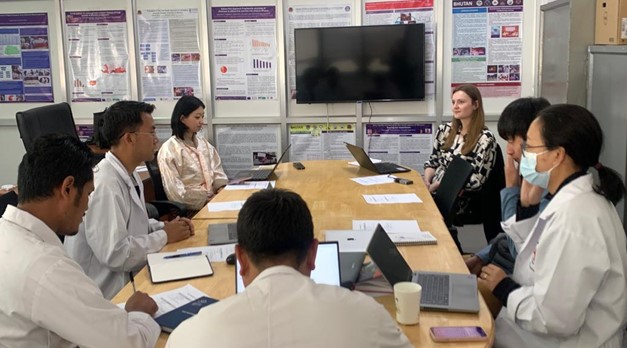The Pandemic Influenza Severity Assessment (PISA) tool was developed by WHO based on the recommendations of the IHR Review Committee on Pandemic Influenza (H1N1) 2009 . It is designed to develop and apply measures to assess the severity of every influenza epidemic. The newly published 2024 PISA guidance update broadens the scope of PISA to include syndromic data as well as influenza-specific data. It uses existing routine surveillance data from countries and relies on the qualitative assessment of four indicators to assess the severity of influenza: transmissibility of an influenza virus, seriousness of influenza diseases, morbidity and mortality and impact on health care capacity.
SEARO is pleased to announce the successful completion of two important PISA training workshops in Bangladesh and Bhutan, facilitated by WHO SEARO and a PISA consultant from WHO Head Quarters. This activity was supported by the Pandemic Influenza Preparedness (PIP) Partnership Contribution (PC) fund.
In Bangladesh, 20 participants from the Institute of Epidemiology, Disease Control and Research (IEDCR) and the International Centre for Diarrhoeal Disease Research, Bangladesh (icddr, b) received training focused on orientating to the WHO average curve and the Moving Epidemic Method for PISA from 21st -23rd April 2024. Both IEDCR and icddr, b data were demonstrated to be suitable for reporting three out of the four PISA indicators namely:
- Transmissibility: % positivity for influenza from ILI surveillance from both IEDCR and icddr, b,
- Morbidity & Mortality: % positivity for influenza from SARI surveillance from both IEDCR and Number of SARI or influenza-confirmed SARI cases from both IEDCR and icddr, b, /OR icddr, b AND
- Seriousness of Disease: proportion of SARI or influenza-confirmed SARI hospitalizations that receive oxygen support from icddr, b
In the future, Bangladesh may also report on the fourth indicator (Impact on healthcare capacity) using healthcare resource monitoring data (proportion of hospital beds occupied).

In Bhutan, the training was provided to 12 participants from the Royal Centre for Disease Control (RCDC) on all three threshold setting methods for PISA from 24th- 26th April 2024. Due to the high quality of the data and the almost year-round circulation of influenza, the WHO average curve method was recommended over other methods and ultimately was used to report on two PISA indicators:
- Transmissibility: ILI composite (i.e., ILI x % positivity for influenza from ILI)
- Morbidity and Mortality: SARI composite (i.e., SARI x % positivity for influenza from SARI)
Bhutan has the potential to use SARI: ILI ratios for the third indicator namely seriousness of disease depending on its usefulness for the country. Further, PISA data for the first 18 weeks of 2024 have already been uploaded to RespiMart by RCDC and are visible in PISA PowerBI outputs.

The application of PISA enables Member States to be better prepared to assess the severity of influenza epidemics or pandemics. To strengthen the capacity of Member States in assessing the severity of future influenza epidemics and pandemics in the region, WHO SEARO, in collaboration with WHO HQ, plans to roll out PISA approach in other Member States. These efforts will help build capacities for enhancing influenza risk assessment, preparedness for, and response to influenza pandemics/epidemics. The efforts of SEARO will be further strengthened by WHO HQ’s plans for continued improvement of training materials and resources to support countries in implementing the updated PISA guidance.
